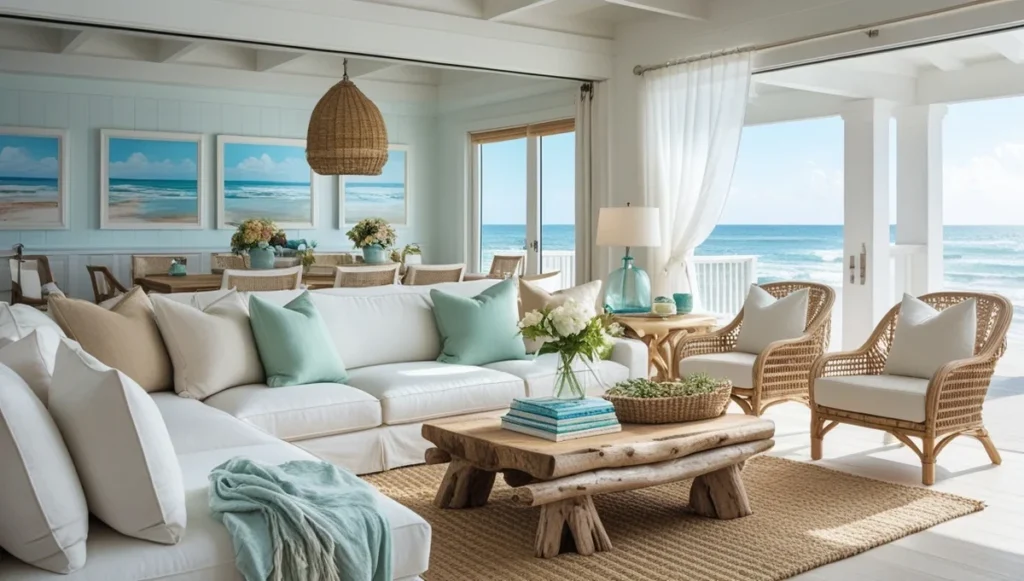- The Timeless Beauty of Portuguese Azulejo: A Designer’s Guide to Bringing Historic Charm into Modern Interiors - September 4, 2025
- Mastering Nautical Interior Design: Beyond the Obvious Anchors and Ship Wheels - September 4, 2025
- Bringing the Tropics Home: A Complete Guide to Tropical Interior Design - September 2, 2025
Table of Contents
Last Tuesday, a client walked into my studio and said, “I want my house to feel like that place we rented in the Outer Banks three years ago.” She showed me photos of a weathered cottage with paint peeling just right, furniture that looked like it had stories, and rooms that seemed to breathe with ocean air. “Can you make my suburban colonial feel like this?” she asked. The short answer? Absolutely. But not by buying everything nautical at HomeGoods.
What Everyone Gets Wrong About Beach House Style
Most people think coastal equals blue and white everything plus some rope and shells. I’ve walked into so many homes that look like someone robbed a maritime museum and scattered the evidence around their living room. Real coastal style? It’s messier than that. More personal. Less coordinated.
Think about actual beach houses you’ve loved. The rental where you had your best family vacation. Your friend’s cottage where you spent that perfect weekend. None of them probably had matching anchor throw pillows, right? They had mismatched furniture that somehow worked perfectly together. Weird collections of things found on walks. Books with sand still stuck in the pages. Quilts that smelled faintly of salt air.
Colors I Actually Use (Spoiler: Not Electric Blue)
Everyone wants to paint their walls that bright Caribbean blue. Don’t do it. I’m begging you. Walk on any real beach and tell me what colors you see. Early morning? Soft grays and pale golds. Midday? Bleached whites and warm sands. Evening? Deeper blues mixed with coral and pink.
My favorite coastal palette came from a photo my client took during a foggy morning in Maine. Weathered gray shingles. Cream-colored stones. Sage grass bending in the wind. Driftwood that had turned silver with age. Those are the colors that work. Subtle. Sophisticated. Easy to live with for more than six months. I keep paint samples from that photo taped to my desk because sometimes the best inspiration comes from just paying attention to what’s actually there.
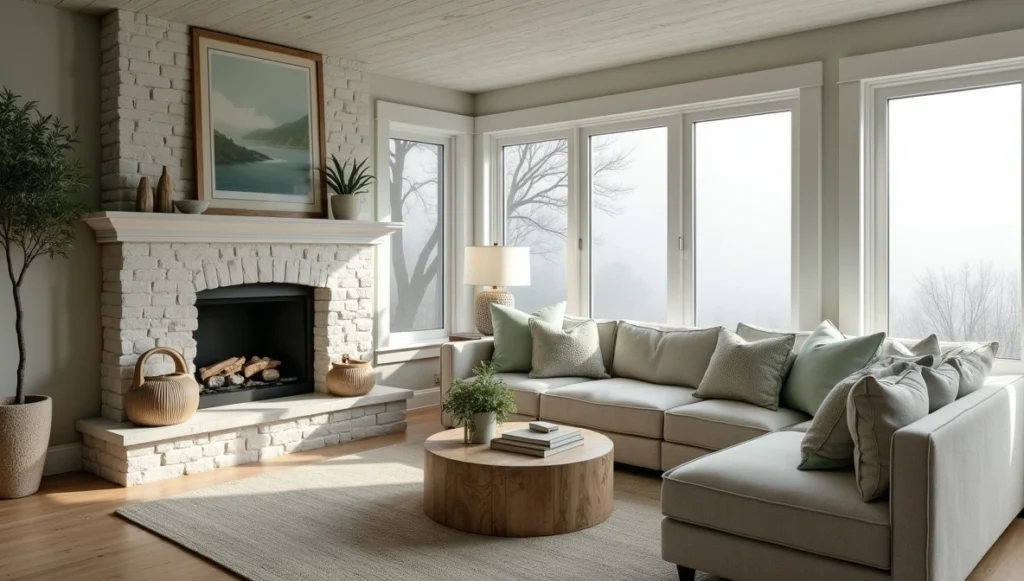
Texture Over Everything
You want to know what makes a room feel coastal? Touch it. Smooth river rocks in a wooden bowl. Nubby linen that gets softer every time you wash it. Jute rugs that feel slightly rough under bare feet. Wood that shows its age in the best possible way.
I found this amazing coffee table last month – made from an old dock that had been underwater for decades. The wood was gray and smooth in some spots, rough and pitted in others. Perfect imperfection. Compare that to the fake distressed furniture at chain stores that’s trying too hard. Real weathering happens slowly, naturally, and tells stories.
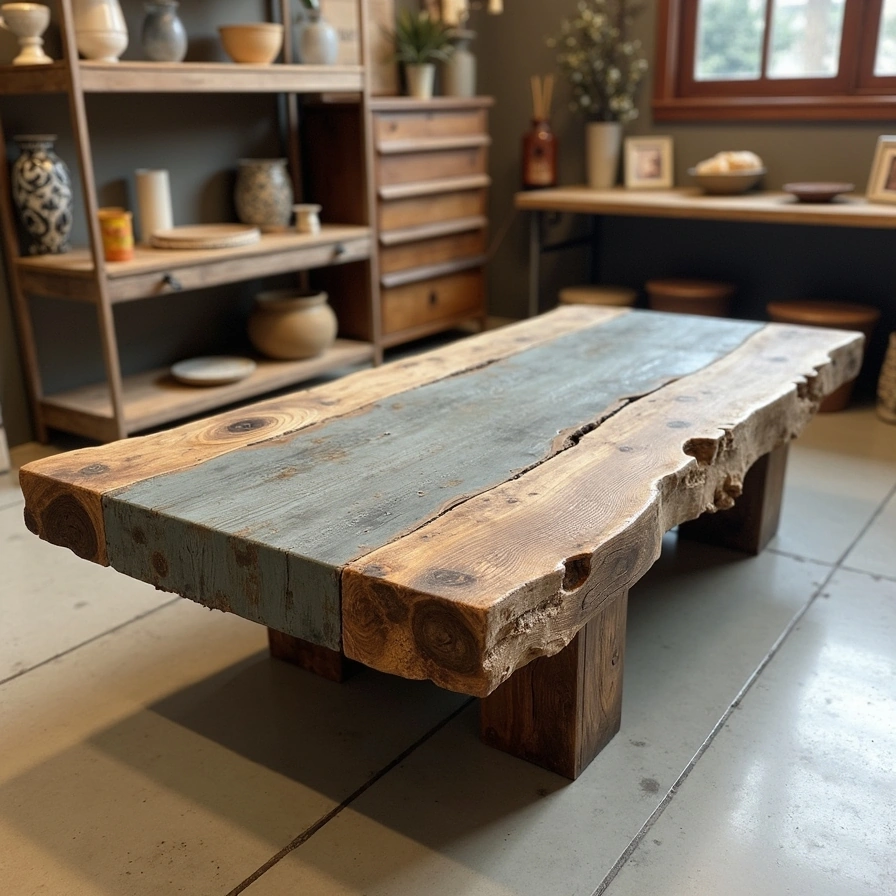
My clients always ask where to find “authentic” coastal pieces. Antique shops near water. Estate sales in old beach towns. Sometimes just patient hunting on Facebook Marketplace. The good stuff takes time to find, but it’s worth the hunt.
Furniture That Makes Sense
Beach houses get lived in hard. Sand everywhere. Wet swimsuits draped over chairs. Kids with sticky fingers. Dogs shaking off after swimming. Your coastal furniture needs to handle reality, not just look pretty in photos.
Slipcovers became my religion early on. Not the formal kind that look like dust covers, but the rumpled, relaxed type that actually improve with washing. I have clients who’ve had the same white linen sofa for a decade. It just keeps getting better looking. Wicker works because it’s honest and doesn’t pretend to be fancy. Neither does weathered teak or pine that’s been around long enough to develop character.
One client inherited her grandmother’s dining table. It was originally pine, and then had been painted white about fifteen times over sixty years. Layers of paint chipping off to show the history underneath. We kept it exactly as it was. Most beautiful piece in her house. Check it out.
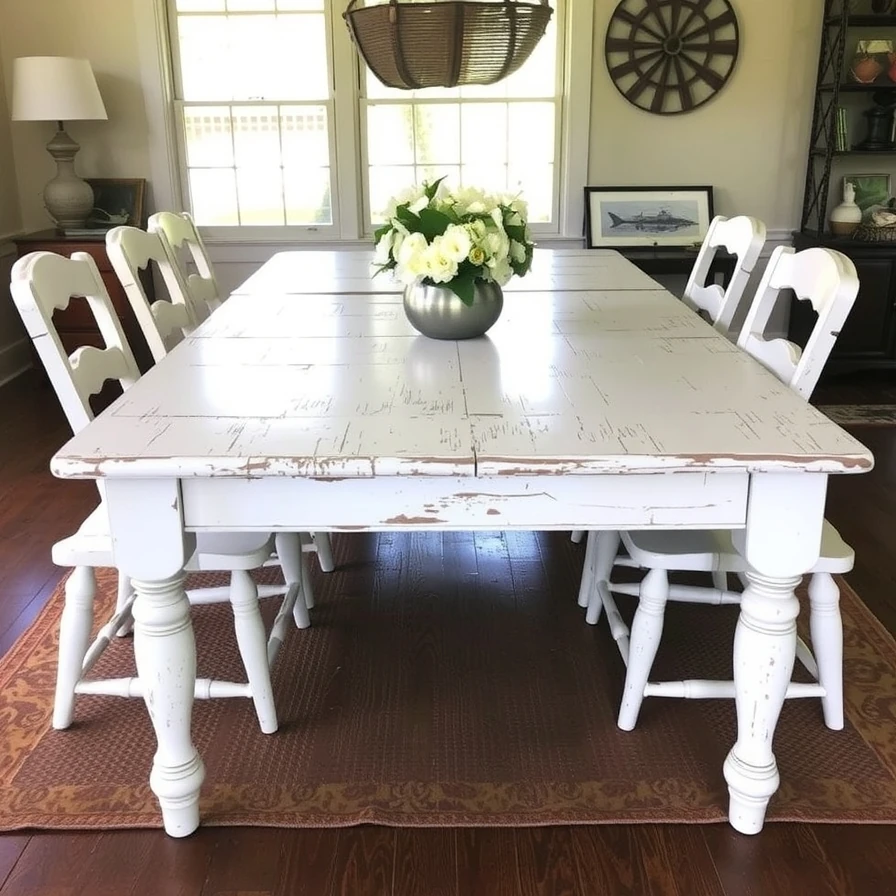
Light Like You Mean It
Overhead lighting kills coastal vibes instantly. When’s the last time you saw fluorescent bulbs at the beach? I’m slightly obsessed with recreating that golden hour feeling indoors. Lamps everywhere. Different heights, different intensities. String lights that make Tuesday night feel like a celebration.
But natural light does most of the work. If you have it, don’t block it. I’ve convinced more than one client to remove upper kitchen cabinets just to let light flow better. Worth every penny of lost storage. Mirrors help too, but not just to “make the room look bigger.” Position them to catch and bounce actual sunlight. Watch how the light moves through your space during different times of day, then put mirrors where they’ll do the most good.
Making Each Room Work
Living Areas: Where Life Actually Happens
Center everything around a big, comfortable sofa where people actually want to sit. Not a showpiece – something you can nap on, eat popcorn on, curl up with a book on. I love sectionals for coastal spaces because they encourage that casual, everyone-pile-on feeling. Add a weathered wood coffee table big enough for games, books, and feet. Storage that doesn’t look like storage – baskets, trunks, benches with hidden compartments.
Plants matter more than most people realize. Not just any plants – ones that feel beachy. Snake plants with their architectural leaves. Palms that whisper in the breeze from ceiling fans. Succulents in weathered pots. They add life and movement that coastal spaces need.
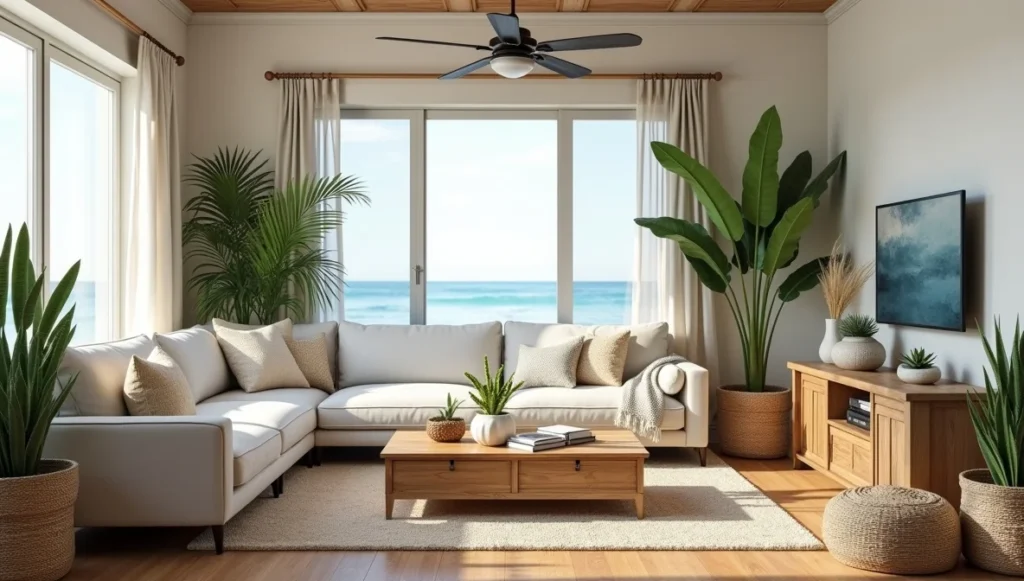
Bedrooms: Your Personal Retreat
Master bedrooms get the luxury treatment, but approachable luxury. Layers of white linens that you can actually bleach when needed. A headboard that looks like driftwood but doesn’t give you splinters. I’m currently obsessed with vintage maritime prints for bedroom walls – not the obvious lighthouse stuff, but old nautical charts, faded photographs of harbors, maps with foxing around the edges.
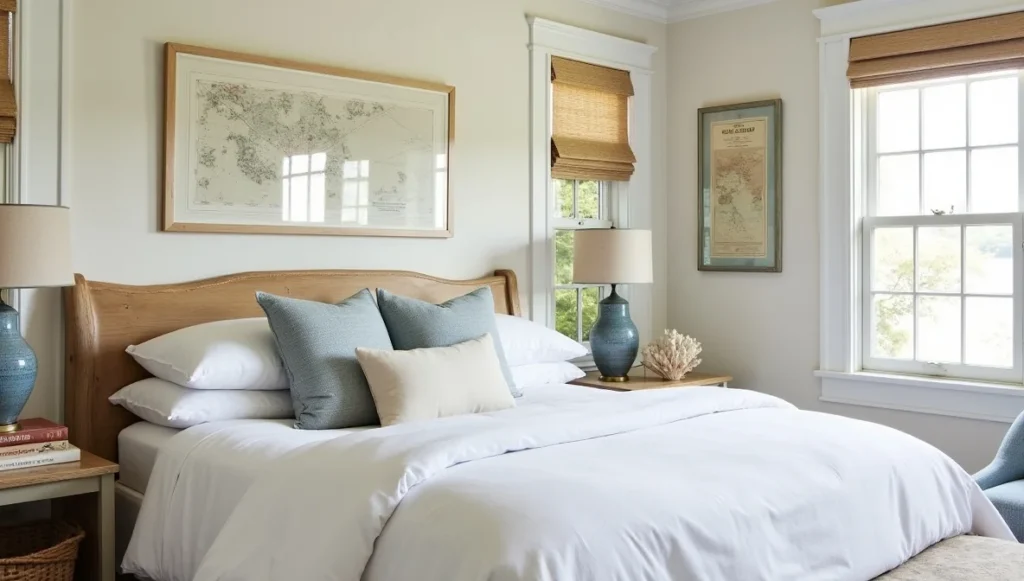
Guest rooms tell stories. This is where collections shine. Sea glass on windowsills. Vintage books about sailing. That weird piece of coral someone brought back from vacation twenty years ago. These rooms should feel like they’ve been collected over time, not decorated in one shopping trip.
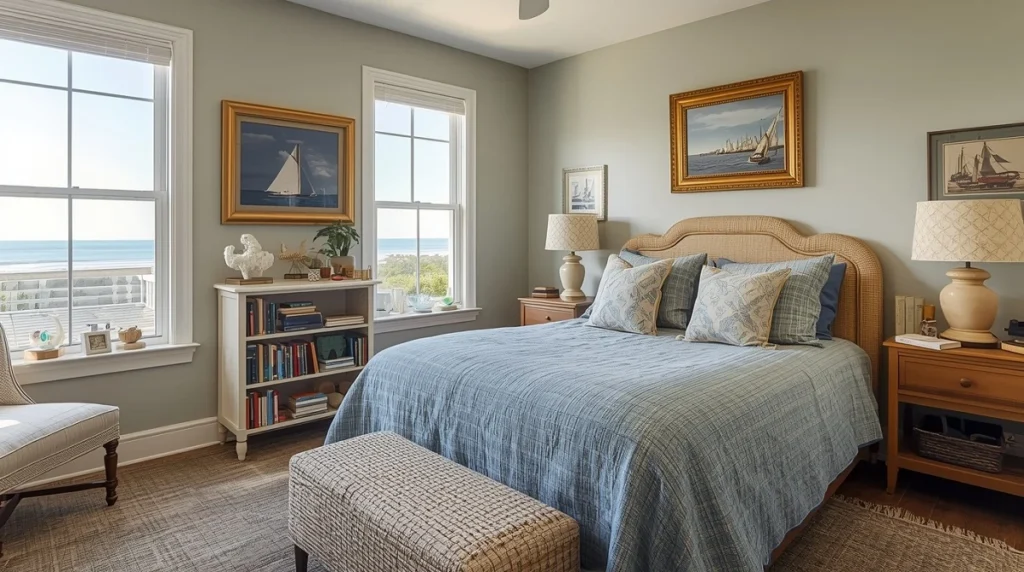
Kitchens: The Real Heart of Coastal Living
Open shelving everywhere possible. Display your everyday dishes – white ironstone, clear glass, maybe some blue and white pottery mixed in. Makes the space feel lived-in rather than staged. Islands need to multitask as breakfast bars, homework stations, cocktail prep areas, and places to dump grocery bags. Use materials that can handle spills and dings without anyone having a panic attack.
I love subway tile backsplashes, but not bright white. Cream, soft gray, even pale sage green work better. Something with just enough color to feel interesting but not enough to date quickly. The goal is timeless coastal charm, not trendy beach house of the moment.
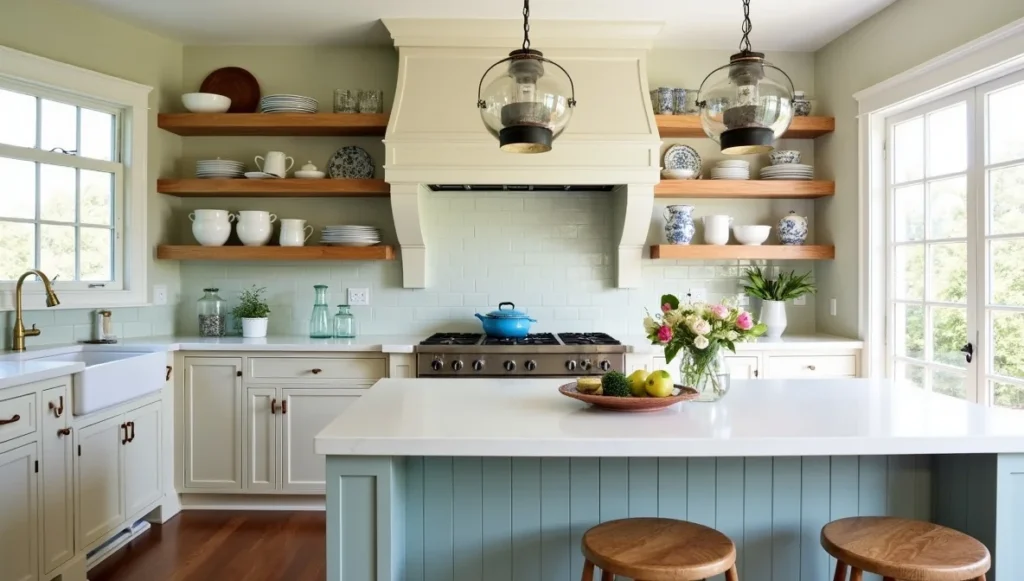
Bathrooms: Mini Spa Experiences
Stone floors that feel good under bare feet work perfectly here. I’m partial to tumbled marble or smooth river rock – anything that reminds you of walking on the beach. Vessel sinks look beautiful in coastal bathrooms, especially when they resemble smooth stones. Pair them with weathered wood vanities and suddenly your bathroom feels like a high-end resort.
Install hooks everywhere for towels and robes. Add open shelving for pretty bottles and baskets. The goal is organized relaxation, not sterile perfection. A good shower with multiple heads and maybe a bench makes the space feel luxurious without being uptight about it.
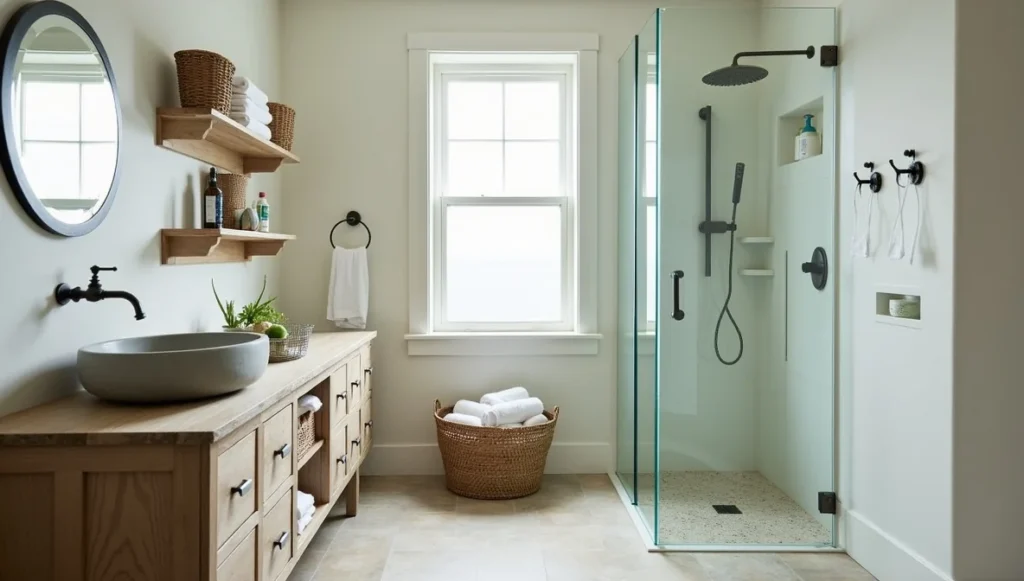
Kids’ Rooms: Adventure Central
Navy and white stripes will never go out of style, but add some unexpected touches. Coral accents, sunny yellow pillows, maybe rope details that can handle enthusiastic play. Built-in bunks designed to look like ship berths make any kid feel like they’re on an adventure. Storage becomes part of the fun – wooden crates for treasures, nets for stuffed animals, hooks shaped like cleats for backpacks.
Most importantly, create something that feels special now but won’t embarrass them later. Classic nautical elements with playful touches beat cartoon themes every time. Think sophisticated sailor rather than SpongeBob.
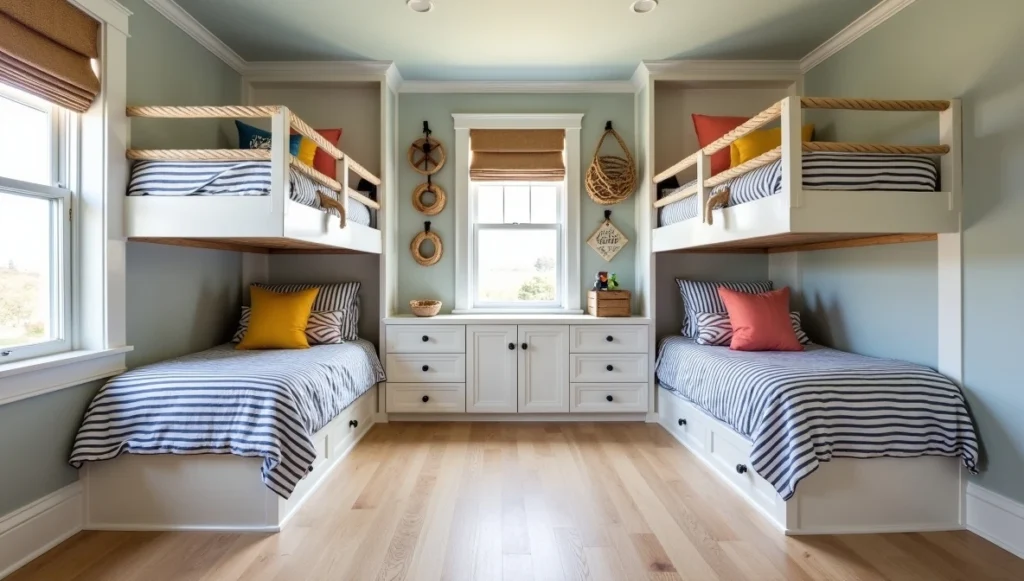
Mistakes That Make Me Cringe
Anchor overload tops my list. One beautiful vintage anchor as art? Perfect. Anchor drawer pulls, anchor lamps, anchor everything? Please stop. Too-perfect weathering is another red flag – that furniture distressed to look old but sold brand new is obvious. Real weathering happens over time, unevenly, with actual stories behind the wear marks.
Theme park coastal makes me want to hide. Your home isn’t a seafood restaurant. Subtle nods to coastal life work better than hitting people over the head with nautical flags and ship wheels. And please don’t forget comfort for looks. Beautiful but uncomfortable furniture defeats the whole purpose of coastal style, which is supposed to be about relaxed living.
Bringing Beach Vibes Inland
Live in Kansas? You can still do coastal style right. Focus on the feelings rather than literal ocean references. Natural light, comfortable furniture, relaxed color palettes, plenty of texture – these elements work anywhere. Plants become crucial when you don’t have ocean views. Palms, ferns, anything that moves slightly in the breeze from your air conditioning adds life and that slightly tropical feeling coastal style needs.
Water features help too, even small ones. A fountain on your deck. Wind chimes that sound like distant waves. Anything that adds gentle, natural sound can transport you mentally to the coast, even from the middle of Nebraska.
The Personal Touch Difference
Every great coastal space tells someone’s story. I have clients who display shells their kids collected during family vacations. Others frame vintage postcards from coastal towns they’ve visited. Someone else has a growing collection of sea glass that started with one piece found during her honeymoon.
These personal elements transform spaces from decorated rooms into homes with soul. They’re conversation starters, memory keepers, and the reason guests always ask about that interesting piece on the mantel. Don’t buy coastal – collect it gradually, with meaning behind each piece.
Why This Style Never Gets Old
Coastal design endures because it’s really about creating peaceful spaces in an increasingly chaotic world. The ocean has this amazing ability to make us feel calm, connected to something bigger than ourselves. Good coastal interiors capture that feeling without needing an ocean view. They remind us to slow down, breathe deeper, maybe kick off our shoes and stay awhile.
My favorite client feedback? “People always seem more relaxed in our house now. Conversations last longer. Kids play more creatively. Even our dog seems calmer.” That’s when you know you’ve nailed it. Not just a pretty room, but a space that actually changes how people feel and behave.
Which is really the whole point, isn’t it? Creating homes that don’t just look good in photos, but actually make life feel a little more like that perfect beach vacation we’re all trying to recreate. Even if the closest ocean is a thousand miles away.
